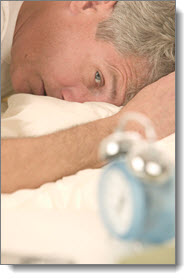Infants can sleep anywhere. As a frequent flyer, I notice this often. In spite of the hustle and bustle of getting the passengers onboard and the roar of jet engines upon takeoff, little ones find dreamland, safely tucked away in the arms of a loved one. This can get you to thinking that sleep is a birthright. It’s not, and this becomes increasingly obvious as we age.
 Primary insomnia is comprised of three components – difficulty getting to sleep, trouble staying asleep and early morning awakenings. A more apt word for insomnia is sleeplessness and people with chronic sleep difficulty may experience all three of these components.
Primary insomnia is comprised of three components – difficulty getting to sleep, trouble staying asleep and early morning awakenings. A more apt word for insomnia is sleeplessness and people with chronic sleep difficulty may experience all three of these components.
The first step to attaining reasonably sound, restful sleep is to confront yourself. Think medical first. Are you having difficulty breathing? Are you in pain? What about restless legs? Significant advances in pharmacotherapy render all of these conditions readily treatable, so consult your doctor. Next, consider what’s going on between your ears. Bedtime is not conducive to worrying about wayward children or cracking the code to a better relationship with your obtuse boss. You’ve got to do these things during the day when you’re naturally more alert.
Then there’s the prickly issue of sleep sabotage. Here’s a short list for delaying your appointment with the sandman:
- Anything with an “i.” i-phones, i-pads, i-pods, i-tunes.
- A light-filled sleeping space.
- Room temperature.
- A heavy meal.
- Alcohol, caffeine, decongestants.
- Stimulating movies (Halloween, Nightmare on Elm Street and The Exorcist are way up there).
Sleep induction, on the other hand is conducive to the following:
- If it has an On/Off switch, choose “Off” at least 30 minutes before bedtime.
- Set the sleeping room temperature at a level comfortable for you, ideally somewhere between shivering and sweating.
- Pray, meditate or read something soothing or boring.
- Take all medication one hour before bedtime. The last thing you need after getting to sleep is a bathroom interruption.
- Tire the mind and the body. Tiring the mind is generally the easier of the two. Getting through the workday means focusing, studying or concentrating on the task at hand. This helps you get to sleep. Tiring the body means moving the body, no matter the vehicle for doing so. This helps you stay asleep.
- If you do nothing else, get the sleeping room as dark as possible. This helps stimulate the secretion of melatonin, a naturally occurring sleep hormone.
What about pharmaceutical sleep aids?
- When taken responsibly, prescription drugs such as Ambien and Lunesta are safe and effective as long as you know what you want the drug to do and for how long. If you’re grieving an uncomfortable loss or traveling through many time zones, it’s perfectly acceptable to take these for a few nights at a time. Months, or even years of use, is an exercise in futility as dosage increases will be inevitable. This is a recipe for dependence.
- Take for 2-3 days and assess the results. Insomnia is often temporary.
- Over-the-counter melatonin, prescription melatonin (Rozerem) or Benadryl may be all you need.
- Keep in mind, that none of these agents, prescription or OTC, will consistently help you stay asleep; they’re more effective at helping you get to sleep.
While you sleep, your brain transforms your day’s experiences into memories and learning, and it releases hormones that fuel growth, build muscle mass and repair tissue. Sleep also releases hormones that fight infections and influence your diet and weight. And since science has yet to uncover why we need it, it’s best to just accept that we do.





Leave A Comment
You must be logged in to post a comment.